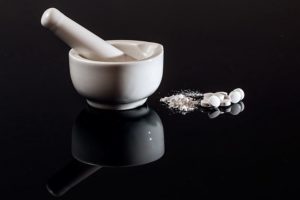If you’re a drug dealer, licit or otherwise, nothing’s going to boost sales for you like some national headlines on how terrible your product is: the more sensational and frightening, the better your business. In fact, drugs meant to make one feel better, licit and otherwise, are probably the only product in the world that benefit enormously from terrible press about the dangers accompanying the taking of it. (If you don’t believe me, ask Purdue Pharma’s accountants how sales looked when the first reports of the coming OxyContin’s epidemic began hitting the media.)
The drug in question here are “bath salts”- a catch-all term for a family of designer drugs called “substituted cathinones”. Those synthetic cathinones are stimulants and the ones most often found in bath salts include methylenedioxypyrovalerone (MDPV), methylone or mephedrone- now please say those three times fast. They’re also currently of disputed legality, and as such, can be legally purchased on the internet.
Central nervous system stimulants are no joke and the psychoactive drugs listed above that are found in the bath salts can certainly be physically addictive. Furthermore, they’ve apparently contributed to a couple of indirect deaths and there have been two reported deadly overdoses. However, as is often the case, the reality of bath salts has been muddled by a healthy dose of panic-mongering.
In a ploy reminiscent of the most sensational Reefer Madness-school scare-theater, the U.S. Navy produced a PSA video on the abuse of bath salts. It follows the perspective of a young sailor who takes some bath salts and goes bowling (after vomiting a stream of something bright yellow off of a bridge). While… bowling on bath salts (also the name of the new Michael Moore documentary), this sailor begins having terrifying hallucinations, attacks his girlfriend, and overdoses (from the same single dose). He winds up in the hospital and then, presumably, the psych ward where he wakes up strapped down and in a psychotic rage before a team of medical personnel come in to inject him with some powerful chemical restraint.
That may not see so far-fetched, though, for those of you familiar with the story of Rudy Eugene, the “Miami Cannibal” who attacked Ronald Poppo, a homeless man, biting and severely injuring the latter’s face in a seemingly cannibalistic assault. Following the horrifying incident, it almost immediately became a sort of unquestioned common knowledge that Eugene was high on bath salts at the time of the attack. So it’s not a long stretch from regular-guy-goes-sufficiently-psycho-to-turn-cannibal on bath salts to hallucinations of one’s friends and significant others as demons.
However- there’s no evidence that Rudy Eugene ever took bath salts (at least on the day of the attack). The only intoxicant found in Eugene’s system was marijuana and as so many jam-band enthusiasts, dorm roommates and literally millions of other cannabis-users are aware- as compelling as the munchies can be, cannibalism is not a side effect of marijuana intoxication. Rudy Eugene had been arrested eight times prior to being shot by police during the Poppo attack, several of those arrests for violence and death threats. While it couldn’t be called “garden variety”, Eugene was undoubtedly suffering from a violent psychosis that had little to do with ingested chemicals.
Once again, overblown and/or faulty drug education or drug-scare messages are counterproductive. Perpetuation of baseless chemical boogeyman stories make the problem worse. It’s an old condemnation that’s been leveled countless times by people interested in an honest and productive conversation about the drug problem, which is the only kind of conversation that will do any good. When a kid who’s done bath salts, or knows someone who has, watches the Navy PSA, there’s an excellent chance they’ll pretty immediately recognize how absurd the premise is. There’s next to no chance that one dose of MDPV will cause vomiting, demon-hallucinations, violent assaults, possible death and violent psychotic seizures.
It’s the same old song: when someone recognizes that the cautionary horror stories they’re being fed about a drug are sensational, unreaslistic and blunderingly manipulative, why would they believe the stuff that’s true? Bath salts, like any stimulant, can absolutely be dangerous. First time use can lead to panic attacks and a rash of other unpleasant, unhealthy and frightening symptoms, possibly including overdose. And also like any stimulant, long term use can lead to nightmare addiction, psychotic episodes, a damaged body and even death (in a handful of cases).
It’s human nature to be frightened of and threatened by new and unfamiliar phenomena. As so many drugs absolutely can be dangerous, addictive, can lead to risky behavior and disease and have the capacity to ruin and/or end one’s life, it’s natural that new ones make people a mite skittish. It’s also human nature to seek out new and pleasurable experiences, so for better or worse drugs aren’t going anywhere and human ingenuity guarantees new ones will be sought and found, or old ones rediscovered. When that happens, those drugs need to be studied, categorized, publicized and dealt with appropriately. Because not doing so makes the problem worse. It’s been nearly 80 years since the release of Reefer Madness and high time (so to speak) we start learning the lesson that bad drug education should have taught us.
Frank Nielson is a retired medical researcher who now spends his days writing. Through his writing, he is keen on helping consumers find the best medical supplies at an affordable price. When not stationed behind his well-worn keyboard, Frank loves spending time with his grandchildren and vows that someday he will tie the perfect fly.




Leave a Reply